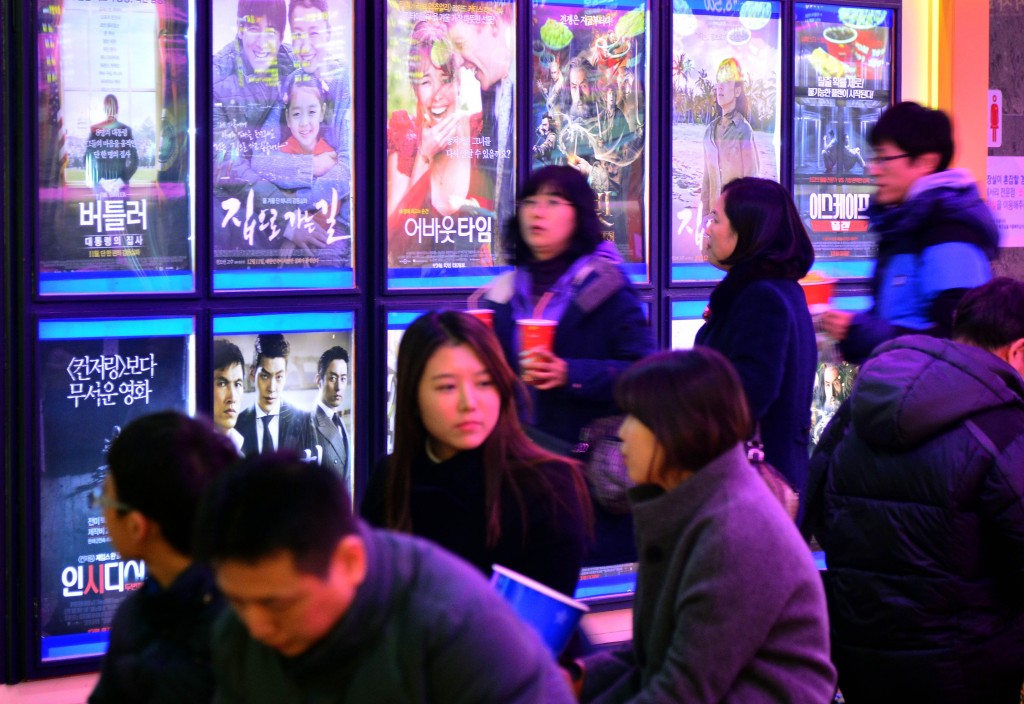- California Assembly OKs highest minimum wage in nation
- S. Korea unveils first graphic cigarette warnings
- US joins with South Korea, Japan in bid to deter North Korea
- LPGA golfer Chun In-gee finally back in action
- S. Korea won’t be top seed in final World Cup qualification round
- US men’s soccer misses 2nd straight Olympics
- US back on track in qualifying with 4-0 win over Guatemala
- High-intensity workout injuries spawn cottage industry
- CDC expands range of Zika mosquitoes into parts of Northeast
- Who knew? ‘The Walking Dead’ is helping families connect
Movie-going tops S. Korean cultural activities
By Kwon Mee-yoo
Movies are the most popular type of cultural experience among Koreans.
According to the 2014 culture enjoyment survey by the Ministry of Culture, Sports and Tourism (MCST), 65.8 percent of the population went to see a movie this year.
The film industry enjoyed success with “Roaring Currents,” an epic film based on the true story of Admiral Yi Sun-shin and his naval victory over Japan during the 16th century Joseon Kingdom, setting a box office record of over 17 million.
The success of “Roaring Currents” attracted many middle-aged people to cinemas, contributing to the 1.4 percentage point increase in the rate of people visiting cultural venues compared to 64.4 percent in 2012.
The second most popular experience was pop music concerts (14.4 percent), followed by stage theater productions (12.6 percent), musicals (11.5 percent) and art exhibitions (10.6 percent).
Overall, 71.3 percent of the population participated in cultural events, an increase from 62.4 percent in 2003 and 69.6 percent in 2012.
The rate exceeded 70 percent for the first time since the first survey in 2003.
The biennial survey showed that the low-income group’s cultural participation rate has dropped.
In 2012, 46.4 percent of households with a monthly income between 1 million won and 2 million won visited cultural venues, but this dropped to 43.7 percent in 2014.
The most common difficulties for appreciating culture and art were its cost according to 35.5 percent of those surveyed.
Other reasons include lack of leisure time (19.1 percent) and a dearth of relevant information (17.2 percent).
The ministry also released its National Leisure Activity 2014 report that showed Koreans spent an average of 3.6 hours a day for leisure and 130,000 won per month on leisure activities.
Lee Hyung-ho, director-general of the Culture Policy Bureau at the MCST, said the ministry will make more efforts to remove cultural disparity.
“We will expand cultural outreach services to let more people benefit from culture vouchers and reduce the cultural gap between social classes,” Lee said at a press conference Wednesday.













![일본 사도광산 [서경덕 교수 제공. 재판매 및 DB 금지]](http://www.koreatimesus.com/wp-content/uploads/2024/07/PYH2024072610800050400_P4-copy-120x134.jpg)



Pingback: SEOUL Weekly: ‘Korean Handicrafts’ & ‘Korea’s Historic Clans’ | SEOUL Magazine
Buy Floxin Online
May 12, 2017 at 7:28 AM
Thanks a lot! It is definitely an wonderful website